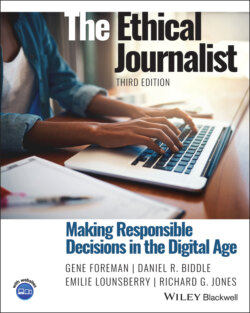Читать книгу The Ethical Journalist - Gene Foreman - Страница 74
Point of View Journalism, Seen From the Other Side
ОглавлениеThey had already drawn a conclusion and were simply collecting facts to dress it up.
By Jane Shoemaker
The writer, now retired, was a reporter for United Press International; a reporter, foreign correspondent and departmental editor for The Philadelphia Inquirer and managing editor of The Charlotte Observer .
AFTER A QUARTER-CENTURY as a reporter and editor, I became head of communications for a regional brokerage and investment‐banking firm. When I switched to the other side, it was an eye‐opener to see the wide variance in standards and ethics from one reporter to the next.
To my distress, I found that far too many journalists are lazy. The lazy ones did not come to an interview prepared, and their shallow questions reflected that. Lazy reporters accepted whatever we told them, not questioning anything. Trade publications and smaller newspapers were alarmingly willing to take my writing and publish it as fact. My news releases often were printed word for word as news stories by publications short of help and eager to fill space. I could have written self‐serving drivel, and readers would not have had any way to know it.
And it was a great surprise to learn how many reporters, particularly those who consider themselves specialists, came to interviews with an obvious bias. They had already drawn a conclusion and were simply collecting facts to dress it up. A telltale sign was questioning intended to back the interviewee into a corner: “Don’t you agree that …?” “Isn’t it true that …?”
Even worse were those who tried to push their own words onto the unwitting subject. I warned executives to be wary of any reporter who said, “So, what you’re saying is ….” or “In other words, ….” That was a red flag that the reporter was choosing the words he or she wanted to attribute to the subject.
We found that many reporters want stories to be black or white. Good guys or bad guys. Right or wrong. The truth is that most events are in shades of gray and need to be presented in perspective. That was particularly difficult when working with television reporters, who hate anything gray because it takes too much time on the air to explain.
The most challenging situation for us was to continue to work with reporters we knew to be lazy or to have a strong point of view. The best was the opportunity to work with reporters who were prepared, ready to listen, willing to learn, and balanced and fair in their stories. Fortunately, there were plenty of them.
28They had already drawn a conclusion and were simply collecting facts to dress it up.
